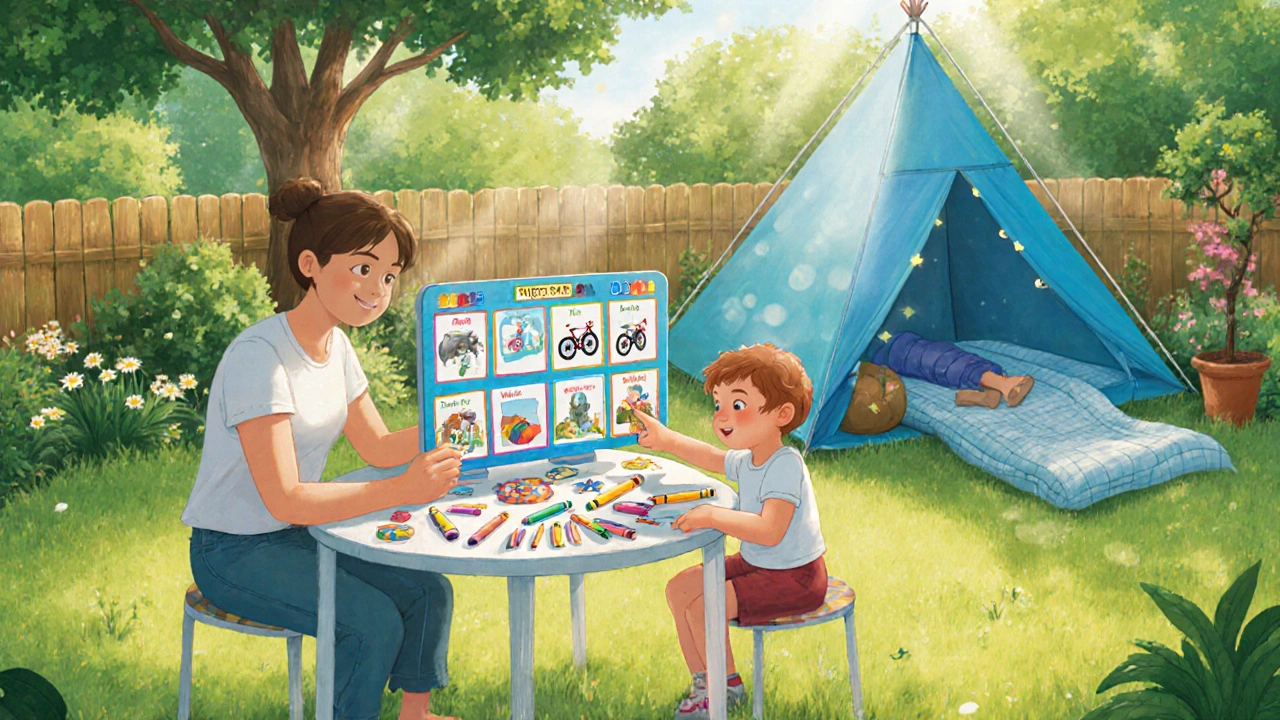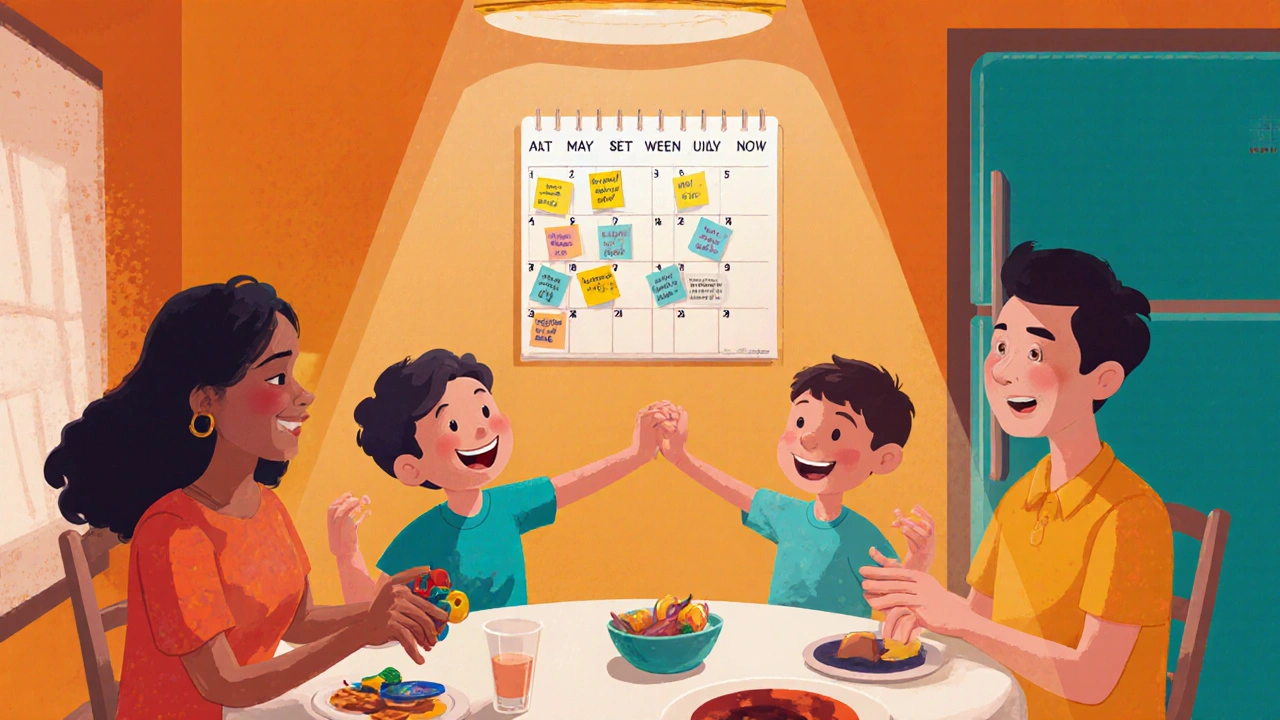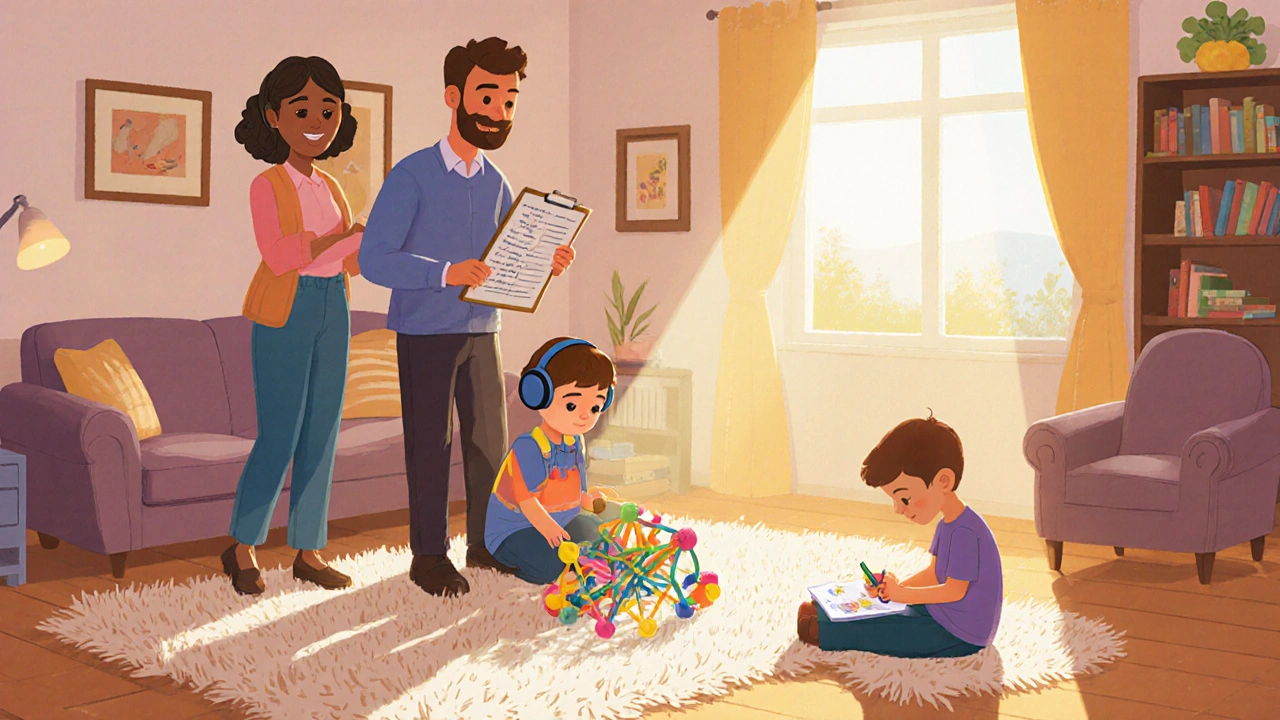In families where a child has Autism a neurodevelopmental condition that affects communication, social interaction, and behavior, the whole household often finds its rhythm reshaped. While the autistic child may need extra routines, the neurotypical siblings-sometimes called Neurotypical child a child whose brain development follows typical patterns-can feel overlooked, confused, or even resentful. Understanding why those feelings surface and how to respond makes the difference between a strained family dynamic and a supportive, resilient one.
Why Sibling Dynamics Matter in an Autistic Family
Research from the University of California, Davis (2023) shows that neurotypical siblings of autistic children are twice as likely to report anxiety or feelings of isolation compared to peers without autistic brothers or sisters. The reason isn’t lack of love; it’s the hidden stressors that sneak into everyday life:
- Attention Split: Parents often juggle appointments, therapy sessions, and crisis management, leaving less one‑on‑one time for the neurotypical child.
- Unpredictable Behaviors: Sensory meltdowns or rigid routines can interrupt play, homework, or family outings.
- Social Misunderstandings: Friends may not know how to react when a sibling’s behavior looks unusual, putting the neurotypical child in the role of educator.
When these pressures stack up, siblings may develop coping mechanisms that can be either healthy-like open communication-or harmful, such as acting out or withdrawing.
Common Challenges Neurotypical Siblings Face
Every family is unique, but most neurotypical siblings confront a handful of recurring hurdles:
- Feeling Invisible: Their achievements can be overshadowed by the constant focus on the autistic sibling’s milestones.
- Guilt: They may feel responsible for the family’s stress, believing they’re somehow causing the meltdowns.
- Confusion About Boundaries: It’s hard to know when to give space and when to intervene during a sensory overload.
- Social Strain: Explaining a sibling’s behavior to friends can be exhausting, leading to fewer invitations.
- Emotional Rollercoaster: The highs of shared victories are often followed by the lows of unpredictable episodes.
Recognizing these pain points early empowers parents to intervene before resentment builds.
Practical Strategies to Support Neurotypical Children
Below are evidence‑backed methods you can start using today. Each tip includes a short rationale so you know why it works.
- Dedicated One‑On‑One Time: Schedule a weekly “sibling date” with a clear start and end. Even 30 minutes of undivided attention lowers anxiety by up to 40% (Australian Parenting Survey, 2022).
- Explain in Simple Terms: Use age‑appropriate language to describe autism. A short analogy-"Your brother’s brain works like a super‑focused camera that sometimes gets stuck on one picture"-helps the neurotypical child understand without feeling weird.
- Involve Them in Routine Planning: Let the sibling help create visual schedules (see Social Story a picture‑based narrative that outlines what will happen next). Participation builds ownership and reduces surprise.
- Teach Self‑Advocacy: Encourage the child to voice needs-"I need a quiet space" or "Can we take a break?"-which also models healthy communication for the autistic sibling.
- Balance Praise: Celebrate achievements of both children equally. A simple “great job on your drawing” right after a therapy session prevents the neurotypical child from feeling left out.
- Provide Sensory‑Friendly Zones: A small tent with soft lighting, noise‑canceling headphones, or a weighted blanket gives any child a calm retreat during high‑stimulus moments.
- Connect with Peer Support: Join a Support Group a regular meeting where families share experiences and resources for siblings. Hearing others’ stories normalizes feelings.

Building a Supportive Home Environment
A family’s everyday atmosphere sets the tone for how siblings cope. Consider these structural changes:
- Transparent Calendars: Hang a family calendar in the kitchen showing therapy appointments, school events, and sibling‑only activities. Visual clarity reduces surprises.
- Noise Management: Invest in rugs, curtains, or white‑noise machines to soften auditory overloads that can trigger meltdowns.
- Clear House Rules: Co‑create a simple list-"We speak kindly," "We ask before we touch"-and post it where everyone can see. Consistency benefits both autistic and neurotypical children.
- Family Check‑Ins: A quick 5‑minute circle at dinner where each person shares a highlight and a challenge promotes empathy.
- Resource Corner: Keep books, sensory toys, and coping cards within arm’s reach so any child can self‑regulate.
Resources and Interventions Worth Exploring
Not every strategy works for every family, so having a menu of options helps you find the right fit. The table below compares three popular supports for neurotypical siblings.
| Support Type | Core Benefit | Typical Cost (AU$) | Time Commitment |
|---|---|---|---|
| Sibling‑Focused Therapy (e.g., Applied Behavior Analysis a structured, evidence‑based intervention for families) | Builds coping skills, reduces resentment | 200‑300 per month | 1‑2 hrs/week |
| Peer Support Groups | Normalizes experiences, provides social outlet | Free‑to‑low cost (often donation‑based) | Monthly meeting (2 hrs) |
| Online Educational Modules | Flexible learning, self‑paced | 30‑100 per course | Variable (30‑60 min per module) |
When choosing, ask yourself: Do we need professional guidance, peer connection, or self‑study? Many families blend two or three options for a balanced approach.

When to Seek Professional Help
If a neurotypical sibling shows persistent signs of depression, aggression, or withdrawal that last longer than a few weeks, it’s time to involve a mental‑health professional. Signs to watch for include:
- Frequent nightmares or sleep disturbances
- Sudden drop in school performance
- Physical complaints (headaches, stomachaches) without medical cause
- Expressions of guilt or blaming themselves for the autistic sibling’s challenges
A child psychologist familiar with Family System the interconnected relationships within a household can tailor therapy that respects both children’s needs.
Quick Recap and Action Checklist
- Schedule regular one‑on‑one time with each child.
- Explain autism in simple, age‑appropriate language.
- Create visual schedules and social stories to set expectations.
- Design a calm‑down corner accessible to all family members.
- Join a sibling support group or explore sibling‑focused ABA sessions.
- Monitor emotional health and seek professional help if red flags appear.
Implementing even a few of these steps can transform a household from “surviving” to “thriving together.”
Frequently Asked Questions
How can I explain autism to a 6‑year‑old sibling?
Use a simple metaphor, like a brain that’s a super‑focused camera that sometimes gets stuck on one picture. Emphasize that everyone’s brain works a little differently, and that’s okay.
What age is right for a neurotypical child to join a sibling support group?
Most groups accept children as young as five, but the key is their ability to express feelings and listen to peers. Check the facilitator’s guidelines for age suitability.
Can sensory tools help the neurotypical sibling too?
Absolutely. Items like noise‑canceling headphones, fidget spinners, or weighted blankets can calm anyone experiencing stress, not just the autistic child.
How often should family check‑ins happen?
A quick daily check‑in (5‑10 minutes) works well for younger kids, while a longer weekly circle can address deeper topics for teens.
When is professional counseling necessary?
If the sibling shows ongoing sadness, anxiety, school decline, or physical complaints tied to stress for more than a few weeks, a qualified child psychologist should be consulted.



18 Comments
Emily (Emma) Majerus
October 16, 2025 AT 20:34Take a few minutes each week just for your kid-you'll see the difference.
Virginia Dominguez Gonzales
October 17, 2025 AT 10:27I totally get how overwhelming it can feel when the spotlight is constantly on one child.
I but remember, the neurotypical sibling has a whole world of feelings that deserve attention too.
Creating a special 'sibling date' carved out of the family calendar can act like a lifeline.
Even if it's just a quick walk to the park or a shared ice cream, that dedicated time says 'you matter'.
Kids pick up on consistency, so scheduling it every Thursday at the same time builds a predictable safe space.
Use a visual cue-like a bright sticker on the fridge-to remind them that this is their moment.
When you sit down together, let them lead the conversation; ask what they’re proud of or what’s bugging them.
Validate their emotions without comparing them to the sibling's challenges.
If they express frustration, acknowledge it: 'I hear you, it can be tough juggling everything.'
Pair that talk with a tiny celebration, maybe a high‑five or a favorite song playing softly.
Over time, this routine strengthens their confidence and reduces the hidden anxiety many report in studies.
You’ll also notice they become more patient and empathetic during the autistic sibling’s meltdowns.
And the whole family feels the ripple effect of that positive connection.
So keep the momentum going, even on days when you’re exhausted-consistency matters more than perfection.
In the end, those small, regular moments become the foundation for a resilient, supportive sibling bond.
Nickolas Mark Ewald
October 18, 2025 AT 03:07Scheduling one‑on‑one time every week is a solid move; kids thrive on predictability.
Just keep it low‑key so it doesn’t feel like a chore.
Chris Beck
October 18, 2025 AT 17:00Look, this whole ‘support the sibling’ spiel is just a way for the government to distract us from real issues-paying taxes, preserving our culture, and keeping our borders secure!; It’s all propaganda, plain and simple. The family unit should focus on patriotism, not these “therapy” gimmicks; otherwise we lose our national identity.
Sara Werb
October 19, 2025 AT 04:07Okay, that’s a lot of noise about borders, but honestly the real secret is that big tech is filming every family counseling session-yeah, they’re mining data from your living room! They want to sell us “sibling support kits” that track emotions and feed it straight to the deep state. Don’t let them get away with it-protect your privacy first!
Winston Bar
October 19, 2025 AT 18:00All this feels like a massive hype train that never actually gets you a better day.
Russell Abelido
October 20, 2025 AT 10:40It’s truly moving to see families rally around each other-every child, regardless of neurotype, deserves that safe harbor.
When you give the “regular” kid a space to voice their worries, you’re essentially building emotional resilience that will pay dividends for a lifetime.
And yes, a simple sensory corner can be a sanctuary for anyone feeling overstimulated, not just the autistic sibling-think of it as a communal calm‑down zone.
Keep the communication lines open, and you’ll notice those little moments of validation spark major confidence boosts.
❤️
Steve Holmes
October 20, 2025 AT 19:00Your point about open communication is spot‑on, and adding a quick daily check‑in can turn the whole family dynamic around.
Even a five‑minute circle where each person shares a highlight and a challenge makes everyone feel heard.
Tom Green
October 21, 2025 AT 08:54Creating a shared visual calendar is a low‑effort, high‑impact tool that keeps everyone in the loop and reduces surprise stressors for the neurotypical sibling.
Emily Rankin
October 21, 2025 AT 20:00Exactly-when the whole household can see what’s coming, the anxiety spikes drop dramatically.
It’s like giving kids a map of their day; they know where the hills are and can prepare for the climb.
Lauren Sproule
October 22, 2025 AT 12:40Hey there, just wanted to add that it’s super helpful to let the neurotypical child pick a “fun” activity they can do with a friend on the days when the schedule is tight.
That way they get social time too, and it eases the feeling of being left out.
genevieve gaudet
October 23, 2025 AT 02:34From a cultural standpoint, many societies have communal child‑rearing practices that naturally embed support for all siblings, so borrowing ideas like shared story‑time circles can be very effective.
Miriam Rahel
October 23, 2025 AT 13:40While the recommendations provided are thorough, one must consider the empirical validity of the cited statistics. The American study referenced lacks methodological transparency, rendering its 40% reduction claim questionable. A more rigorous meta‑analysis would be advisable before adopting such strategies universally.
Samantha Oldrid
October 24, 2025 AT 03:34Oh sure, because adding another “sibling date” will magically erase decades of systemic neglect-yeah right.
lisa howard
October 24, 2025 AT 11:54Let me just say something here: the entire narrative around sibling support feels like a polished PR campaign designed to keep parents pacified while the real issues go unaddressed.
First, we’re told to schedule one‑on‑one time, but who’s actually supervising that schedule? Usually it’s a frazzled parent who’s already juggling therapy appointments, work, and the endless loop of emotional labor.
Second, the idea of “visual schedules” assumes every child can process visual cues the same way, ignoring neurodiversity within neurotypical children themselves-some kids simply don’t respond well to calendars and become more anxious staring at a wall of pictures.
Third, the recommended “sensory corners” often become a liability when they’re repurposed as a quick fix for meltdowns, rather than a thoughtful, personalized space that considers the specific sensory profile of each child.
Furthermore, the emphasis on “self‑advocacy” doesn’t account for power dynamics at home; a younger sibling may feel intimidated to voice needs in the presence of an older, more dominant sibling.
And let’s not forget the hidden cost: these strategies demand time-time that many families simply don’t have due to socioeconomic constraints.
All of these points mean that while the guide appears comprehensive, the practical implementation may actually increase stress for families who cannot meet these idealized standards.
So before we all jump on the bandwagon of “best practices,” perhaps a more grounded approach that acknowledges real‑world limitations would be a step in the right direction.
Cindy Thomas
October 25, 2025 AT 01:47Interesting points, but I’d argue that the data supporting sibling‑focused interventions is still shaky.
Without robust longitudinal studies, we risk over‑promising outcomes that may not materialize.
Kate Marr
October 25, 2025 AT 18:27We need to protect our families from these radical inclusion tactics that undermine traditional values 🇺🇸.
Patricia Echegaray
October 26, 2025 AT 02:47Don’t be fooled-these “support programs” are just another way for global elites to monitor our homes through data‑harvesting toys and apps.
They’re feeding us a narrative of inclusion while silently collecting every tantrum, every whisper, and every secret that happens behind closed doors. Wake up, people!